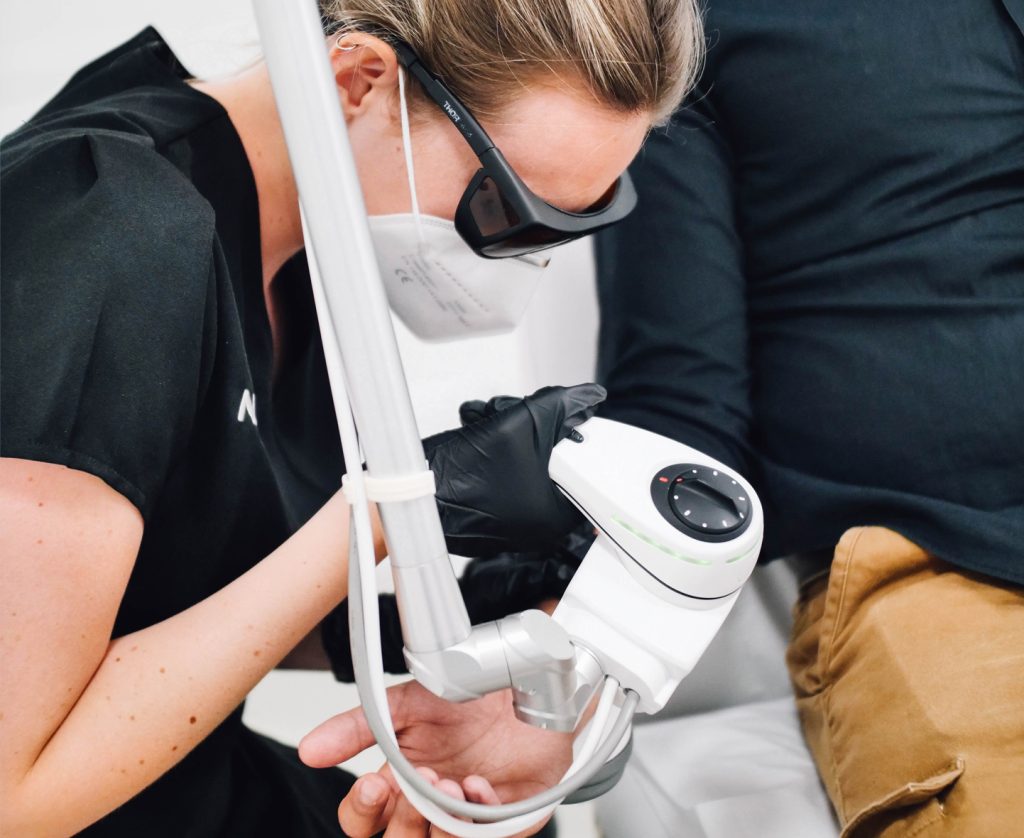A common question about laser tattoo removal is whether it is difficult to remove red ink pigment. This question likely stems from the perception that red ink has, in the past, been troublesome to remove.
With advances in laser tattoo removal technology, this needn’t be the case. We will hear about how the LightSense™ laser system has been used to effectively treat red tattoos from expert consultants at NAAMA Studios in London.
We’ll also dive into the academic research going on right now in aid of safer red ink pigments for all.
The consultant’s view on removing red ink tattoos
NAAMA Studios is the only place where the LightSense™ laser system is available. Their consultants have become experts at using the laser on a variety of skin tones for treating an array of tattoo colours and designs.
Verity, Clinical Lead at NAAMA Studios, reports that, “It seems with red tattoos that it really depends on the type of ink used. Often we have very good tattoos removals in only a few sessions with red ink, using the 532 LightSense™ laser system.”
Clearly, the type of ink used in the original design will impact the efficacy of the removal process. But it is possible to quickly and effectively remove a red ink tattoo.

How often are red ink tattoos removed?
Ben, Data Analyst at NAAMA, has documented the rates of removal for different colour tattoos. “Red ink removes slightly faster than black ink, but the vast majority of tattoos we remove are black.”
“A lot of the tattoos that have red in them will actually be black and red rather than just red.”
The mixing of ink pigments in tattoo design complicates our understanding of how fast different inks clear from the skin. This is where the academic research into tattoo inks comes in.
To dig deeper into how quickly red inks remove we need to examine the murky world of tattoo inks.
Red inks are changing
To begin with, it is important to make clear that the way we make red ink pigment for tattoo design has changed a lot over recent history.
John Swierk, assistant professor at Binghamton University, says that, “the pigments that were used in tattoos historically were just the pigments that were available to artists 50-60 years ago, they weren't necessarily chosen because they were specifically ideal for this purpose.”
As tattooing has professionalized the search for safe and high-quality tattoo inks has intensified.
“There's a tonne of space to reimagine what a tattoo pigment is, how it works, and what you can improve,” he adds.
What’s in my red ink?
Much of the research today focuses on what we actually put in red inks, specifically to replace the ingredients that are known to cause adverse effects.
“Historically, red tattoo inks were coloured with cinnabar, or mercury sulphide, with their adverse reactions of course being attributed to that mercury content,” Matthew Kiszla, M.D. Candidate at the University of Alabama at Birmingham Heersink School of Medicine, tells us.
“Now, however, we know that these red inks are being coloured with entirely different agents, which are typically organic rather than metallic salts. These agents are known as azo dyes or as azoic compounds - in reference to their key double bonds between two nitrogen atoms.”
The negative perception of red ink pigment in tattoo design is persistent, though thankfully, not as persistent as the red ink particles themselves during laser tattoo removal.
“Even today, red tattoo inks continue to be thought of as the most problematic. However, there are other warm-hued colourants that involve azo dyes. So, what differentiates the red azo dyes from the yellows? Their structures look quite similar on paper. Understanding why reds might be a little bit more problematic requires more research.”
Campaigns for safe red ink
As a response to adverse red ink reactions mainstream brands have stepped into the niche world of tattoo ink manufacturing.
When tomato sauce giant Heinz collaborated on their own skin-safe red ink earlier this year, in part an homage to their hordes of Heinz ketchup red-tatted fans, they made it clear that there is an appetite for innocuous red ink tattoo pigment.
How the LightSense™ laser system removes red ink safely
The LightSense™ laser system has been designed to remove a broad range of colour tattoo inks by operating at different wavelengths. Darker colours absorb a broader spectrum of light, whereas lighter colours absorb a narrow range of wavelengths.
During a consultation for laser tattoo removal one of the key things the laser expert is looking to understand is the type of ink used in the tattoo.
The simplest ink colours to remove are black, blue, green, and deep purple. At the other end of things, white is the hardest tattoo colour to remove.
The LightSense™ laser system operates using the following wavelengths:
800 nm:
The LightSense S2 800 nm Ti:Sapphire laser system is indicated for tattoo removal for Fitzpatrick Skin Types I-III.
532 nm:
The LightSense S2 532 nm Nd-YAG laser system is indicated for tattoo removal for Fitzpatrick Skin Types I - III.
1064 nm:
The LightSense S2 1064 nm Nd-YAG laser system is indicated for tattoo removal for Fitzpatrick Skin Types I-VI.
To discover more about the capabilities of the LightSense™ laser system, watch it in action below, or speak to the experts at NAAMA studios in London.


